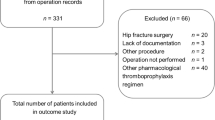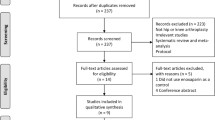Abstract
Introduction
Rivaroxaban is the first licensed oral direct inhibitor of factor Xa. Recent studies from the RECORD trials suggest rivaroxaban has superior efficacy compared to enoxaparin in preventing venous thromboembolism (VTE) with no significant increase in the major bleeding risk. Concerns remain regarding the incidence of minor bleeding, consequent delayed wound healing and subsequent risk of infection. The aim of this observational study was to assess the incidence of post-operative complications in patients receiving either rivaroxaban or enoxaparin thromboprophylaxis following elective hip and knee arthroplasty.
Methods
A total of 258 patients undergoing elective total hip or knee arthroplasty within one NHS Trust were included. A total of 202 subjects (mean age, 70.7 years ± 10.0, 43 % men) received a daily dose of 10 mg of oral rivaroxaban and 56 (mean age, 70.9 years ± 9.8, 39 % men) had a daily subcutaneous injection of 40 mg of enoxaparin as thromboprophylaxis. Endpoints included VTE (deep vein thrombosis and pulmonary embolism), haemorrhagic wound complications, hospital re-admission, requirement for blood transfusion, minor and major bleeding and death.
Results
There were no significant differences in the incidence of VTE, requirement for blood transfusion and readmission rate between rivaroxaban and enoxaparin-treated patients. The incidence of minor bleeding (2.0 vs. 0 %) and haemorrhagic wound complications (5.0 vs. 1.8 %) were non-significantly higher in the rivaroxaban-treated group. There were no cases of pulmonary embolism, major bleeding or death in either group.
Conclusion
Our experience with rivaroxaban in elective hip and knee arthroplasty showed no significant difference in the incidence of VTE or major bleeding. There was, however, a tendency to greater risk of minor bleeding and wound complications that were largely haemorrhagic in nature, which may have reached significance in a larger study.
Similar content being viewed by others
References
Geerts WH, Pineo GF, Heit JA, Bergqvist D, Lassen MR, Colwell CW et al (2004) Prevention of venous thromboembolism: the Seventh ACCP Conference on Antithrombotic and Thrombolytic Therapy. Chest 126(3 Suppl):338S–400S
Paiement GD, Mendelsohn C (1997) The risk of venous thromboembolism in the orthopedic patient: epidemiological and physiological data. Orthopedics 20(Suppl):7–9
Cardiovascular Disease Educational and Research Trust, Cyprus Cardiovascular Disease Educational and Research Trust, European Venous Forum, International Surgical Thrombosis Forum, International Union of Angiology, Union Internationale de Phlébologie (2006) Prevention and treatment of venous thromboembolism. International consensus statement (guidelines according to scientific evidence). Int Angiol 25:101–161
Wolowacz SE, Roskell NS, Maciver F, Beard SM, Robinson PA, Plumb JM et al (2009) Economic evaluation of dabigatran etexilate for the prevention of venous thromboembolism after total knee and hip replacement surgery. Clin Ther 31(1):194–212
Eriksson BI, Borris LC, Friedman RJ, Haas S, Huisman MV, Kakkar AK, et al (2008) Rivaroxaban versus enoxaparin for thromboprophylaxis after hip arthroplasty. N Engl J Med 358(26):2765–2775
Kakkar AK, Brenner B, Dahl OE, Eriksson BI, Mouret P, Muntz J et al (2008) Extended duration rivaroxaban versus short-term enoxaparin for the prevention of venous thromboembolism after total hip arthroplasty: a double-blind, randomised controlled trial. The Lancet. Elsevier 372(9632):31–39
Lassen MR, Ageno W, Borris LC, Lieberman JR, Rosencher N, Bandel TJ, et al (2008) Rivaroxaban versus enoxaparin for thromboprophylaxis after total knee arthroplasty. N. Engl. J. Med 358(26):2776–2786
Turpie AG, Lassen MR, Davidson BL, Bauer KA, Gent M, Kwong LM, et al (2009) Rivaroxaban versus enoxaparin for thromboprophylaxis after total knee arthroplasty (RECORD4): a randomised trial. The Lancet 373(9676):1673–1680
National Institute of Clinical Excellence (NICE) (2009) TA170 Venous thromboembolism—rivaroxaban: guidance www.nice.org.uk. Cited 28 Feb 2012. Available from: http://www.nice.org.uk/TA170
Atkins RM (2010) NICE and venous thromboembolism. J Bone Joint Surg Br 92(5):609–610
Jensen C, Steval A, Partington P, Reed M, Muller S (2011) Return to theatre following total hip and knee replacement, before and after the introduction of rivaroxaban: a retrospective cohort study. J Bone Joint Surg Br 93(1):91
Lotke PA (2008) Rivaroxaban for thromboprophylaxis. N Engl J Med 359(20):2174; author reply 2175–3176
National Intsitute of Clinical Excellence (NICE) (2010) Venous thromboembolism—reducing the risk (CG92) www.guidance.nice.org.uk. Cited 1 Mar 2012. Available from: http://guidance.nice.org.uk/CG92
Cusick LA, Beverland DE (2009) The incidence of fatal pulmonary embolism after primary hip and knee replacement in a consecutive series of 4253 patients. J Bone Joint Surg Br 91(5):645–648
Turpie AGG, Lassen MR, Eriksson BI, Gent M, Berkowitz SD, Misselwitz F et al (2011) Rivaroxaban for the prevention of venous thromboembolism after hip or knee arthroplasty. Thromb Haemost 105(3):444–453
Byrne AM, Morris S, McCarthy T, Quinlan W, O’byrne JM (2007) Outcome following deep wound contamination in cemented arthroplasty. Int Orthop 31(1):27–31
Fender D, Harper WM, Gregg PJ (1999) Outcome of Charnley total hip replacement across a single health region in England: the results at five years from a regional hip register. J Bone Joint Surg Br 81(4):577–581
McCullagh L, Tilson L, Walsh C, Barry M (2009) A cost-effectiveness model comparing rivaroxaban and dabigatran etexilate with enoxaparin sodium as thromboprophylaxis after total hip and total knee replacement in the Irish healthcare setting. Pharmacoeconomics 27(10):829–846
Turpie A, Jamal W, Schmidt A, Lassen M, Mantovani L, Kreutz R, et al (2011) XAMOS: a non-interventional study of rivaroxaban in the prophylaxis of venous thromboembolism after hip or knee surgery. J Thromb Haemost 9(Suppl 2):961
Conflict of interest
The authors have no conflicts of interest to declare.
Author information
Authors and Affiliations
Corresponding author
Rights and permissions
About this article
Cite this article
Sindali, K., Rose, B., Soueid, H. et al. Elective hip and knee arthroplasty and the effect of rivaroxaban and enoxaparin thromboprophylaxis on wound healing. Eur J Orthop Surg Traumatol 23, 481–486 (2013). https://doi.org/10.1007/s00590-012-0987-y
Received:
Accepted:
Published:
Issue Date:
DOI: https://doi.org/10.1007/s00590-012-0987-y




